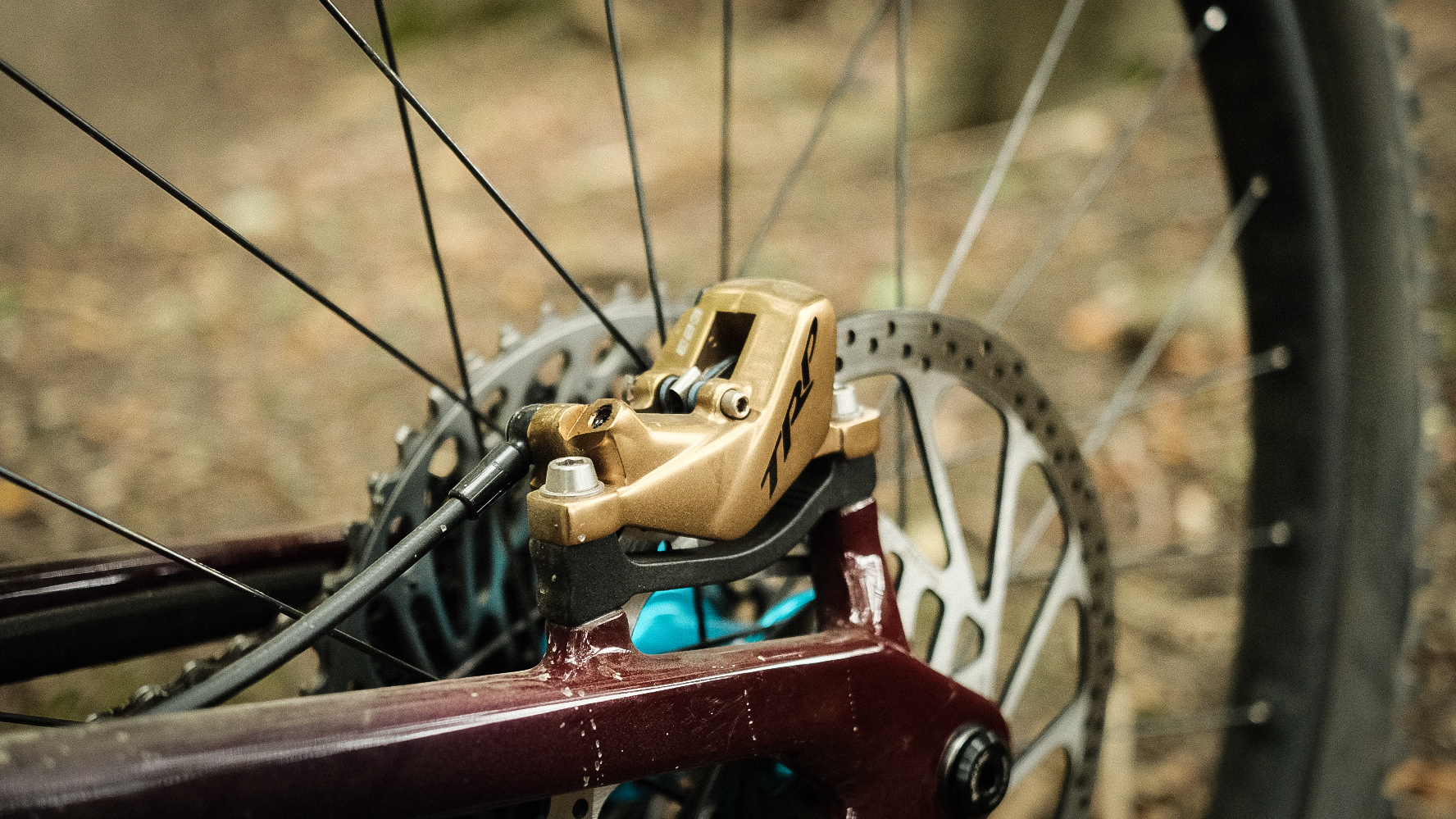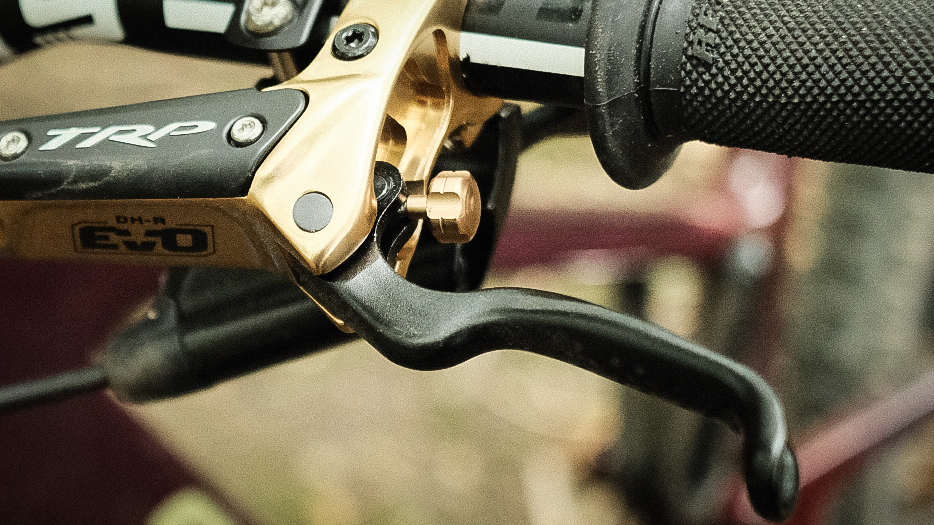Bike Perfect Verdict
The DH-R Evo's performance and power puts them right up there with the best brakes currently available.
Pros
- +
Fantastic amounts of well modulated power
- +
Consistent even in testing circumstances
- +
Great reliability
- +
Supplied pad compound is excellent
Cons
- -
Single sided specific
- -
No contact adjustment
- -
Some lever flex when pulled hard
Why trust BikePerfect
Visually, the DH-R Evo looks similar to its ‘Quadiem’ and ‘DH-R’ predecessors; brakes that in our opinion were underwhelming and low on stopping power, but thankfully TRP have introduced a serious of updates and changes which make the DH-R Evo one of the best mountain bike brakes currently available.
For information on Bike Perfect's testing procedures and how our scoring system works, see our how we test page.
The original DH-R development started when World Cup downhill racer Neko Mulally installed a set of prototype TRP e-bike brakes to his bike in-search of more power and performance. The DH-R Evo brake we have here is the most up to date product of this extensive research and development, but what have they done to achieve such a leap in performance?
Design and specifications
The DH-R Evo still operates using mineral oil to push the pads on to the rotors, but an updated oil formula is said to have a higher boiling point to improve feel and consistency during hard sustained braking. The hydraulic hose itself has also been downsized from 5.5mm down to 5mm with the aim of generating more hydraulic pressure for a stiffer lever feel. The narrower diameter should also offer better compatibility for frames with internal cable routing too.
The lever body itself now uses a 9mm piston which alters the leverage rate to provide more power for less effort – something that in turn should require less effort from the rider, meaning there’s less chance of premature arm pump or fatigue. The lever blade features a host of dimples for a more predicable feel, and its ergonomic shape fits the braking finger well. There’s a tool-less reach adjust dial to tune set-up, but interestingly TRP still don’t feature any kind of contact adjustment dial. While this does add simplicity, it also limits set-up customization, which is a feature we’d like to see on a brake of this price.
At the caliper end, the DH-R Evos use a two piece design which houses four equally sized hybrid pistons. The pistons push out a new organic compound pad which TRP state helps to improve braking power, reduce noise and limit bleeding in time. Another bonus is the pad shape is the same as Shimano’s four-piston offerings, which should mean finding replacements in pretty much any bike shop will be a cinch should you get stuck. That said, we do think TRP’s latest pad compound is one of the best available.
Where the DH-R Evo’s vary from most is that they’re designed to be run with thick 2.3mm width rotors which according to TRP makes a big difference to overall stiffness and cooling capacity when compared to ‘standard’ 1.8mm thick discs. Obviously, extra material means additional weight, but we think it’s worthwhile considering the increase in performance. TRP offer the rotors in various sizes from 180-223mm, which means there’s a suitable size for most riders regardless of their style of riding.

Performance
The DH-R Evos installation is as easy as it gets when it comes to fitting brakes, with the lever and hose pre-filled with fluid and bungs in place to prevent spillage it’s as close to plug and play as you get – something that any home mechanic will appreciate, especially if the bike in question has internal cable routing. I’ve fitted them to several bikes (World Cup race bikes) with zero issues now, just a quick lever bleed (which almost wasn’t necessary!) and I was off. I noticed the bed-in process to be much faster than any other new brakes I’ve tried recently too, something I put down to TRP’s new pad formula.
After months of countless lift assisted laps in the Alps I’ve put the DH-R Evos through a wide range of scenarios in pretty much every weather condition, and performance remained powerful and consistent throughout the entire testing process. The solid initial bite almost takes some adjusting too at first, and several times during the initial stages of testing the immediate power caught me off guard and my previous braking points had to be adjusted to suit the TRP’s intense and immediate braking forces. What’s more impressive than the sheer power though is how it’s always consistently delivered, and even at the end of 10+ minute descents where letting off the brakes simply isn’t an option, the lever feel remained the same and I never experienced even the slightest sign of brake fade. The consistency continues into the after care too, and unlike some other brand’s brakes there’s no need to bleed them relentlessly either.

It isn’t all perfect with the feel though and I did experience some unwanted lever flex when braking hard – this isn’t a major flaw but definitely alters the lever feel slightly. To fix this I suspect TRP would either have to alter the clamping point or introduce the addition lever support to the bar we’ve seen on newer Shimano brakes.
While the lever has marginal flex, the 2.3mm thick rotors certainly don’t and they’re something that contribute to the solid feel and excellent heat dissipation. TRP claim the leap in rotor thickness improves stiffness by 47 percent when compared to a 1.8mm rotor, and while this isn’t something I can measure, it’s certainly something I can feel the positive benefits of on the trail.
At $229 / £210 (without rotor), they’re cheaper than SRAM Codes, but more expensive than Shimano Saints and the perfectly scoring Hope Tech 4 E4s we also tested recently. The price difference between them all certainly isn’t massive but it’s worth a mention, especially when rotors and mounts need to be bought additionally.
Verdict
There’s no shortage of high-power four-piston brakes on the market currently, but the power, consistency and reliability of the DH-R Evo’s puts them right up there with the best. There were times I missed having pad contact adjustment and the lever flex may be noticeable if you’re feel sensitive, but all in all, with the modulation sitting somewhere in the middle ground of the competition and power being equal to the main favorites, the DH-R Evo’s should 100 percent be on your consideration list, especially if neither SRAM's Code or Shimano’s Saint suit your desired feel.
The DH-R Evo’s performance and wider rotors make them ideal for the extra weight of e-bikes too – so if you’re struggling to slow down your e-beast, these are a sorted solution.
Tech specs: TRP DH-R EVO brakes
Price: $229 / £210 (each)
Colors: Gold, Silver, Black
Weight: 310G (each)

Jim Bland is a product tester and World Cup downhill mechanic based in North Yorkshire, England, but working Worldwide. Jim’s chosen riding genre is hard to pinpoint and regularly varies from e-bike-assisted shuttle runs one day to cutting downcountry laps the next. Always on the hunt for the perfect setup, Jim will always be found comprehensively testing kit with World Cup racing levels of detail. His ultimate day out includes an alpine loam trail, blazing sunshine, and some fresh kit to test.
Rides: Santa Cruz Hightower, Santa Cruz v10, Specialized Kenevo.
Height: 170cm
Weight: 64kg

